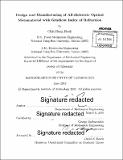| dc.contributor.advisor | George Barbastathis. | en_US |
| dc.contributor.author | Hsieh, Chih-Hung, Ph. D. Massachusetts Institute of Technology | en_US |
| dc.contributor.other | Massachusetts Institute of Technology. Department of Mechanical Engineering. | en_US |
| dc.date.accessioned | 2015-12-03T20:54:41Z | |
| dc.date.available | 2015-12-03T20:54:41Z | |
| dc.date.copyright | 2015 | en_US |
| dc.date.issued | 2015 | en_US |
| dc.identifier.uri | http://hdl.handle.net/1721.1/100120 | |
| dc.description | Thesis: Ph. D., Massachusetts Institute of Technology, Department of Mechanical Engineering, 2015. | en_US |
| dc.description | Cataloged from PDF version of thesis. | en_US |
| dc.description | Includes bibliographical references (pages 103-106). | en_US |
| dc.description.abstract | Gradient index (GRIN) materials offer the most general manipulation over wave fields of light compared to conventional refractive optics, where the light is deflected by the curved surface. The creative way to implementing GRIN optics is to construct a subwavelength structure with the electromagnetic characteristics that are unavailable via the natural material. This artificial GRIN structure also known as "metamaterial" can be classified into two general categories: film and slab GRIN optics, depending on the propagation direction of light penetrating through or propagating along the metamaterial. In this dissertation, two different purposes of all-dielectric GRIN optics on (1) film: light extraction enhancement of the scintillator; (2) slab: aberration-free focusing using Lüneburg lens, are both investigated. The scintillator made by ceramics like Lutetium Yttrium Orthosilicate (LYSO) possesses higher index of refraction at 1.82 than the surrounding environment, which causes extraction loss due to index mismatching and total internal reflection (TIR) from scintillator to photodetector. A hybrid structure including two-dimensional photonic slab covered by the nanocone structure on the top was devised to recycle the energy loss from TIR and to create an index-matching layer in between. Design parameters of the hybrid structure were optimized by the simulation based on rigorous coupled-wave analysis, and the fabrication of hybrid structure was patterned by nanospheres (for nanocone structure) and laser interference (for photonic slab) lithography, respectively. Reactive ion etching (RIE) facilitated pattern transfer after two separate lithography processes. Finally, the characterization of nanostructured scintillator was performed with the ionizing source. The rest of this research focuses on the implementation of the slab GRIN optics: Nanostructured Lüneburg lens. The Lineburg lens is an aberration-free lens that can perfectly focus light on the opposite edge of the lens area, and such property can be used for light coupling from fiber to waveguide in the Silicon photonics. We designed the nanostructured Lineburg lens on the silicon-on-insulator substrate using effective index of refraction computed by photonic band theory, and the fabrication was carried out by the e-beam lithography and RIE process. The device characterized by near-field scanning optical microscopy exhibited the single focusing behavior under fundamental mode illumination via the intensity map over the lens region. In addition, the bi-foci phenomenon under higher order mode illumination was also revealed in the finite difference time domain simulation, and the ray picture for explaining the bi-foci was also included using Wigner distribution function and Hamiltonian ray-tracings. | en_US |
| dc.description.statementofresponsibility | by Chih-Hung Hsieh. | en_US |
| dc.format.extent | 106 pages | en_US |
| dc.language.iso | eng | en_US |
| dc.publisher | Massachusetts Institute of Technology | en_US |
| dc.rights | M.I.T. theses are protected by copyright. They may be viewed from this source for any purpose, but reproduction or distribution in any format is prohibited without written permission. See provided URL for inquiries about permission. | en_US |
| dc.rights.uri | http://dspace.mit.edu/handle/1721.1/7582 | en_US |
| dc.subject | Mechanical Engineering. | en_US |
| dc.title | Design and manufacturing of all-dielectric optical metamaterial with gradient index of refraction | en_US |
| dc.type | Thesis | en_US |
| dc.description.degree | Ph. D. | en_US |
| dc.contributor.department | Massachusetts Institute of Technology. Department of Mechanical Engineering | |
| dc.identifier.oclc | 929650633 | en_US |
